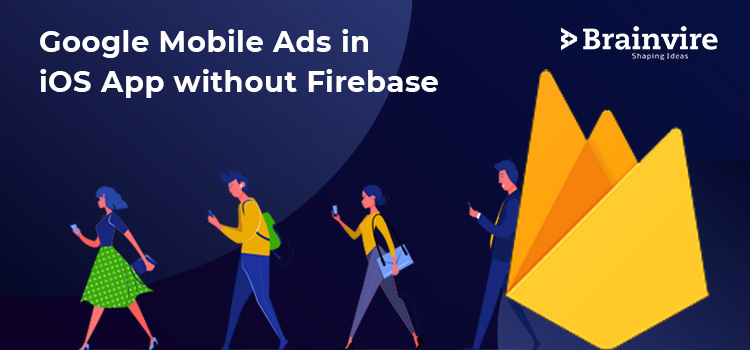
91% people commit that they run a quick mobile search to learn and/or purchase a product or service. Mobile advertising is the best way to reach your audience. Pop-up ads can be annoying and can cost you a customer but not anymore!
Google Mobile Ads can be the next major step that your business must take to reach your audience swiftly. Google Mobile Ads instead of unwanted pop-up ads can be lucrative for your business.
An iPhone app development company can recommend how to make optimal use of Google Mobile Ads. This integration can eliminate one of your primary pain points- reaching your customers. Over 50% consumers get familiar with a new product through mobile search.
Google Mobile Ads possesses the capability to provide your enterprise with the much-needed visibility among the right audience.
In this extract, we will focus on the following-
- Basics about Google Mobile Ads (iOS)
- Perks of Google Mobile Ads
- Different Types of Ad Formats That You Can Select
Basics about Google Mobile Ads (iOS)
A thorough understanding about Google Mobile Ads(iOS) can help you monetize an iOS app without using Firebase. All you need is a simple integration with AdMob.
In case, you are confused between the two options, then it is important to understand both individually and then compare their pros and cons.
Here, we are likely to discuss more about Google Mobile Ads (iOS) without Firebase.
The biggest advantage of integrating Google Mobile Ads SDK into an iOS app is that it allows you to display ads seamlessly. Alongside, it increases your revenue.
After the successful integration of the SDK, you can also implant different ad formats. These ad formats are discussed in detail further in the article.
Before you dive into different ad formats, it is important to know more perks of Google Mobile Ads.
Perks of Google Mobile Ads
Apart from increased revenue, Google Mobile Ads are beneficial to your organization in the following ways-
Goal Oriented
Google Mobile Ads can be designed and displayed in interactive and attractive formats. This makes it easier to grab the attention of your potential consumer. Besides, you can include an effective and goal-oriented call to action to your ad.
For instance, if you want to bring more audience to install your app, then you can display ads that compels them to click on the install option.
On the contrary, if you are just getting to know your audience, then you can simply include a survey question in your ad.
Google Mobile Ads is Pay-Per-Click (PPC), this means that you have to pay only if a potential customer clicks on the ad and that what is ppc agency do all to acquire new customers.
Reach the Right Audience
The optimal use of Google Mobile Ads allows you to tap on the right audience. You can use the right set of keywords to reach your potential audience.
For example, a Japanese restaurant owner can use the right keywords related to Japanese cuisine in their ads to reach people who are interested in this particular cuisine.
This way, you will no longer waste time and resources on uninterested or wrong audiences. You can also use location-specific keywords to narrow your audience search to a particular location.
Track Conversions
Your Google Ads Account comprises robust and advanced conversion tracking tools. These tools can notify you about essential business data such as
- Response of your advertisements
- Number of clicks
- Number of downloads
Apart from these, it can also note any other action taken by your potential consumers.
This information gives you a better perspective about what customers like about your ads and what you can avoid in the future campaigns. Are people from a different location visiting your website, regularly?
If yes, then you can tap on that location and increase your reach.
All the data accumulated from Mobile Ads can make it convenient for your customers to call, visit, or make purchases from you.
Different Types of Ad Formats That You Can Select
Discussed here are some common ad formats that you can choose for your Google Mobile Ads (iOS)-
Banner Ads
Ads that occupy a specific spot on the app’s layout are known as banner ads. These ads are primarily visible either on the bottom or the top of the mobile screen. They stay on the screen while the user uses the app but refreshes automatically at frequent intervals.
As a beginner in the world of Google Mobile Ads, banner ads can be the best option to start with.
We have shared an ideal approach to integrate banner ads with AdMob into an iOS app-
- Begin the process by importing Google Mobile Ads SDK.
- Introduce a separate view section in your hierarchy to display ads. SEO Experts suggest to use programmatically or interface builder for the same.
- Create your ads well in advance so that you can test them before they go live. Displaying an ad without a test can have large scale consequences. Approach an expert to test the ads.
- Once you have configured the required properties, it’s time to load an ad.
Furthermore, there are 2 types of banners-
- Adaptive banners- These are next-gen responsive banner ads that can optimize ad size and device performance. These banners make wise use of the limited screen space. It is important to follow all the required rules and regulations and select the right ad slot.
- Smart banners- Smart banners take into account the device size and create the ad view accordingly. Generally, the height of smart banners in iPhones is 32 points for landscape and 50 points in portraits. When you make use of a shorter image, then the image gets centered and the extra space on both sides is filled in black.
Interstitial Ads
These are full screen ads that consume the entire interface of the app. The ad gets dispersed only when it’s closed by a user. Transition points are the most ideal spots to place them.
You can place them at the start while the app is getting ready or while switching pages. An interstitial ad gives the user an opportunity to either click on it or close it, and switch to the app again.
Native Ads
Native ads comprise similar UI components as that of the app. These ads have a similar storyboard and class that blends easily with the app’s visual design. When a native ad loads it is the app’s action more than the SDK performance. This makes it difficult to customize the ad layout.
Native ads can be uploaded on the app with two important steps-
- Load the ad through SDK
- Display the ad content in the app
When it comes to native ads, it is important to run test ads and then load them for smooth execution.
Native templates offer a helping hand for quick modification and implication of native ads. It takes a couple of minutes to implement the first native ad. Moreover, you don’t have to write complex codes to customize the look and feel of the ad.
There are two template sizes-small and medium represented by a class. You can use the template view to ensure execution of the right size.
Native ads also provide the custom mute this ad option so that uninterested audiences can mute the ad.
You can also use native video ads for Google Mobile Ads to create brand awareness about your company.
Rewarded Ads
Rewarded ads offer users an opportunity to gain something in return for interacting/participating with the ad. For instance, a hair shampoo runs a survey ad and offers free coupons to potential customers who participated in the survey.
Want to know more about Google Mobile Ads (iOS)?
Related Articles
-
A PEEK INTO MARKETING AUTOMATION
One of the most talked about subject in the SEO industry is marketing automation which can be nearly defined to as a technology that is designed for marketing organizations so
-
Boost Your Revenue With Upselling And Cross-Selling
The revenues potential of customers does not end immediately at the point of sale. There are opportunities beyond the initial buy, and cross-selling and upselling practices may help you tap
-
Customer Story: The Digital Marketing Journey of a Coupon Aggregator
Today, digital marketing is used for digital branding as well as digital retailing. Digital Marketing has increased in the last few years, with startups embracing digital mediums. In today’s digital



